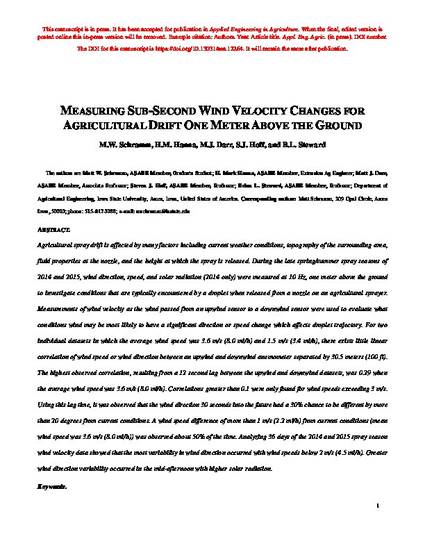
Agricultural spray drift is affected by many factors including current weather conditions, topography of the surrounding area, fluid properties at the nozzle, and the height at which the spray is released. During the late spring/summer spray seasons of 2014 and 2015, wind direction, speed, and solar radiation (2014 only) were measured at 10 Hz, one meter above the ground to investigate conditions that are typically encountered by a droplet when released from a nozzle on an agricultural sprayer. Measurements of wind velocity as the wind passed from an upwind sensor to a downwind sensor were used to evaluate what conditions wind may be most likely to have a significant direction or speed change which affects droplet trajectory. For two individual datasets in which the average wind speed was 3.6 m/s (8.0 mi/h) and 1.5 m/s (3.4 mi/h), there exists little linear correlation of wind speed or wind direction between an upwind and downwind anemometer separated by 30.5 meters (100 ft). The highest observed correlation, resulting from a 12 second lag between the upwind and downwind datasets, was 0.29 when the average wind speed was 3.6 m/s (8.0 mi/h). Correlations greater than 0.1 were only found for wind speeds exceeding 3 m/s. Using this lag time, it was observed that the wind direction 30 seconds into the future had a 30% chance to be different by more than 20 degrees from current conditions. A wind speed difference of more than 1 m/s (2.2 mi/h) from current conditions (mean wind speed was 3.6 m/s (8.0 mi/h)) was observed about 50% of the time. Analyzing 36 days of the 2014 and 2015 spray season wind velocity data showed that the most variability in wind direction occurred with wind speeds below 2 m/s (4.5 mi/h). Greater wind direction variability occurred in the mid-afternoon with higher solar radiation.
Available at: http://works.bepress.com/mark_hanna/258/

This is a manuscript of an article published as Schramm, M.W., H.M. Hanna, M.J. Darr, S.J. Hoff, and B.L. Steward. "Measuring Sub-Second Wind Velocity Changes for Agricultural Drift One Meter Above the Ground." Applied Engineering in Agriculture (2019). DOI: 10.13031/aea.12264. Posted with permission.